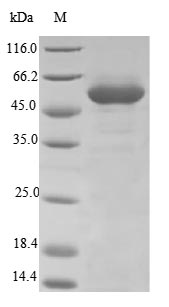Recombinant Arabidopsis thaliana Flavonol 3-O-glucosyltransferase UGT71C1 is expressed in E. coli and includes the full-length protein (1-481 amino acids) with an N-terminal 10xHis-tag for ease of purification. The product demonstrates a purity level greater than 85% as verified by SDS-PAGE. This preparation is intended for research use only, ensuring reliable results for scientific investigations.
Flavonol 3-O-glucosyltransferase UGT71C1 appears to be an enzyme involved in the biosynthesis of flavonoids, a group of plant secondary metabolites. These compounds play essential roles in plant development and defense. UGT71C1 carries out the glucosylation process, which likely influences the solubility and stability of flavonoids. This makes it a valuable tool for researchers studying plant metabolic pathways and their regulation.
Potential Applications
Note: The applications listed below are based on what we know about this protein's biological functions, published research, and experience from experts in the field. However, we haven't fully tested all of these applications ourselves yet. We'd recommend running some preliminary tests first to make sure they work for your specific research goals.
Arabidopsis thaliana UGT71C1 is a plant glycosyltransferase that requires precise folding, proper active site formation, and UDP-glucose cofactor binding for its enzymatic activity in flavonoid glucosylation. The E. coli expression system cannot provide the optimal eukaryotic folding environment or post-translational modifications that may be important for this plant enzyme's full functionality. The N-terminal 10xHis-tag is relatively small and may cause minimal steric interference, but the prokaryotic expression system may still affect proper folding and cofactor binding. While the full-length protein (1-481aa) contains all functional domains, the probability of correct folding with full enzymatic activity requires experimental validation.
1. In Vitro Enzyme Activity Characterization
This application requires functional validation. UGT71C1 enzymatic activity depends on precise tertiary structure and cofactor binding. If correctly folded and active (verified through activity assays), the protein may be suitable for kinetic studies. If misfolded/inactive (unverified), kinetic measurements will yield biologically meaningless results.
2. Substrate Specificity and Inhibitor Screening Studies
This application carries a significant risk without functional validation. Substrate recognition and inhibitor binding require native enzyme conformation. If correctly folded and active (verified), limited screening may be possible. If misfolded/inactive (unverified), specificity and screening results will be unreliable.
3. Protein-Protein Interaction Studies
This application requires proper folding validation. UGT71C1 interactions with metabolic partners require precise tertiary structure. If correctly folded (verified), the protein may identify physiological interaction partners. If misfolded/unverified, there is a high risk of non-specific binding or failure to replicate genuine protein interactions.
4. Antibody Development and Validation
This application is highly suitable as antibody development relies on antigenic sequence recognition rather than functional enzymatic activity. The full-length protein provides comprehensive epitope coverage for generating antibodies against UGT71C1.
5. Structural and Biophysical Analysis
These studies are essential for determining folding status. Techniques should include circular dichroism spectroscopy to assess secondary structure, size-exclusion chromatography to evaluate oligomeric state, and thermal shift assays to determine stability.
Final Recommendation & Action Plan
The E. coli expression system may produce folded UGT71C1 protein, but enzymatic functionality requires experimental validation. Begin with Application 5 (Structural and Biophysical Analysis) to assess folding quality through CD spectroscopy and SEC. Validate enzymatic activity using flavonol substrates and UDP-glucose cofactor before considering functional applications (1, 2, 3). Application 4 (antibody development) can proceed immediately. For reliable enzymatic studies, always include activity controls and consider the potential impact of the prokaryotic expression system on plant enzyme functionality.






